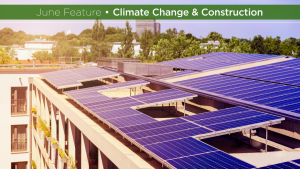A Canadian company based in Nova Scotia is gathering wide-spread attention for technology that injects captured CO2 into cement and concrete products.
CarbonCure Technologies Inc. in Dartmouth, N.S., began development of its multi-patented process in 2007. The company’s technology involves injecting a precise dosage of CO2, sourced from industrial emitters, into the concrete mix where it becomes permanently embedded. This carbon would have been released into the atmosphere.
“Approximately one pound of CO2 is saved per every 30 standard concrete masonry unit. On average 25 pounds of CO2 are saved per every cubic yard of ready mix concrete made with the CarbonCure technology,” says company spokesperson Rebecca Hussman. Further to that, the company says their process reduces carbon emissions from the concrete manufacturing plant itself while measurably improving the strength of the concrete.
Research conducted by Thomas Concrete Inc., a global producer with over 130 plants across Europe and the USA, confirms the impressive carbon reduction statistics cited by CarbonCure.
“To put it in perspective, every 20 trucks of concrete will save the same amount of CO2 emissions as an acre of forest will sequester over the course of a year,” according to a report in ConcreteProducts.com.
The industry finds itself between a rock and a hard place, as carbon emissions associated with the widespread use of concrete is being addressed by governments globally.
“Each year, more than four billion tonnes of cement are produced, accounting for around eight per cent of global CO2 emissions,” says a Chatham House report from the Royal Institute of International Affairs, an independent policy institute based in London, U.K.
“To bring the cement sector in line with the Paris Agreement on climate change, its annual emissions will need to fall by at least 16 per cent by 2030.”
The industry is, in fact, making changes to reduce its carbon footprint. For example, the Chatham House report says that European cement plants currently operate on 90 per cent non-fossil fuels. There is also increased adoption of Supplementary Cementitious Materials (SCM) such as fly ash or slag, seen as economical and sustainable alternatives to Portland cement clinker, used to augment the hydration reaction during curing.
CarbonCure’s unique process offers a possible new path that addresses the requirements of both builders and regulators. The company says that Environmental Product Declarations (EPDs) and Health Product Declarations (HPDs), available through producer partners’ transparency documents, means their technology can help contribute to a project’s LEED certification.
The benefits of CarbonCure’s technology are not limited to carbon reduction — it also results in a measurably stronger product.
“Concrete dosed with CO2 using the CarbonCure process typically results in 10 per cent higher strength at one, seven and 28 days,” according to Thomas Concrete’s research.
Cost implications for cement manufacturers are minimal, according to Rebecca Hussman of CarbonCure. “Adopting the CarbonCure technology into their plants is a win-win situation — they can reduce the carbon footprint of their concrete while enabling production efficiencies. No upfront capital expenditure is required to adopt the technology, and the costs associated with installing and sourcing the CO2 actually even out with the production efficiencies that the technology enables.”
CarbonCure is a finalist in the $20 million Carbon XPRIZE challenge, where Team CarbonCure will be demonstrating new CO2 Capture and Utilization/Storage technology currently being developed in Calgary, Alta. with the assistance of Emissions Reductions Alberta.
Acceptance of CarbonCure’s technology is growing beyond Canada’s borders. As reported in Construction Dive, Hawaii’s Department of Transportation (DOT) used CarbonCure’s technology for recent highway construction. After finding the carbon-injected material was stronger, easier to work with, and added no extra cost, the Hawaii DOT, “plans to use carbon-injected concrete in all construction as part of its climate change solution and has approved for all flat work, like roads and sidewalks, and is being tested for use in vertical projects.”
John Bleasby is a Coldwater, Ont. based freelance writer. Send comments and Inside Innovation column ideas to editor@dailycommercialnews.com









Recent Comments